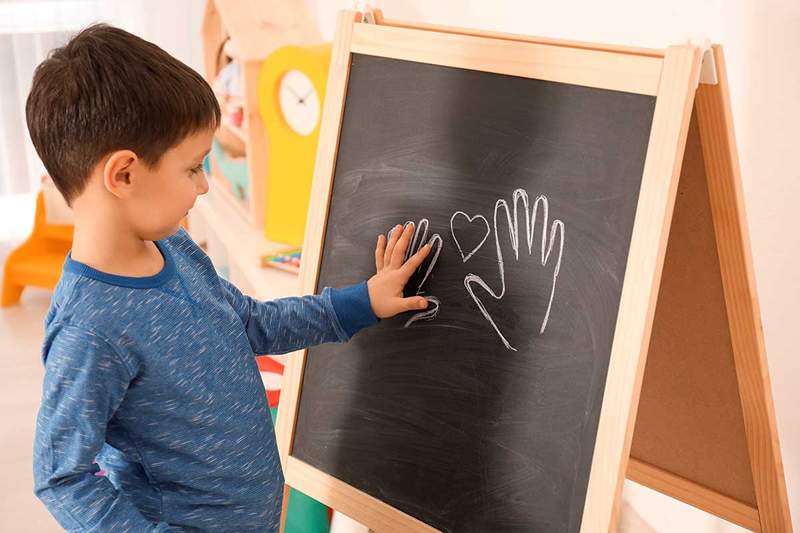Post -traumatic stress disorder in childhood and adolescence

- 1058
- 345
- John Von
Post -traumatic stress disorder (PTSP) develops in certain people after experiencing or witnessing a traumatic event. It is also known as emotional trauma, the term "trauma" comes from the Greek τραῦμα (trauma = wound).
Content
Toggle- Childhood and adolescence, critical stages
- Potentially traumatic events
- Emotions and development in childhood
- Effects of children's traumas on adulthood
- 12 tips to help children overcome adverse events
- References
Childhood and adolescence, critical stages
These stressful experiences can occur throughout life, however Critical stages are considered childhood and adolescence. Due to the program that our DNA possesses, progressively molding as our nervous system develops. Neurodevelopment begins in conception and transcurre throughout life until ending in death. Nevertheless, Brain maturity requires all children's stage and is completed in adolescence, This means that these two stages become the most vulnerable, therefore adverse events have more intense impact on these two stages and development process.
Potentially traumatic events
Below are some potentially traumatic events (although they do not necessarily have to become PTSD):
- Emotional, sexual or physical abuse,
- Emotional or physical negligence,
- Direct abuse or violence to a loved one,
- Natural disasters or accidents,
- Conflicting separation or divorce,
- Results of a state of poverty (not having housing, poor food),
- Substance abuses at home,
- Complicated separation of loved ones,
- Natural disasters or serious accidents,
- Unpredictable behavior of primary caregivers due to certain addictions or psychopathologies.
The adverse experiences caused by various psychosocial and epigenetic components have proven to be the origin of many psychopathologies and pathologies, as stated by the "Theory of multifactorial origin of mental disorders”(Rutter, 2009).
 Prosocial behavior in children and their benefits
Prosocial behavior in children and their benefits Emotions and development in childhood
Brain structures that are responsible for regulating emotions, Memory and behavior are mainly developed in childhood, they are very vulnerable to the damage caused to the responses of emotional or physical stress (Van der Kolk, 2002; van der Kolk, 2003).
Certain events such as early social negligence in children have a greater index of delays in different areas of the process related to different cognitive and linguistic responses (APA, 2013). Differences have been demonstrated in certain brain structures through neuroimaging techniques in people who have experienced continued adverse events in addition to showing irregular brain activity (Bergherr, Bremner, Southwick, Charney and Krystal, 1997; Southwick et al., 1999).
It also affects the hypothalamus-hypofiso-supranal system (Serra, 2003); People who have lived some traumatic event show abnormal levels of stress hormones (Carpenter, Shattuck, Tyrka, GeraciTi, and Price, 2011) and the brain parts responsible for regulating stress usually respond in a less adaptive way to those shown the memories or experiences associated with trauma, causing maladaptive and destructive responses in the psychosocial, emotional, relational and physiological contour (Soler, 2008). On the other hand, chronic stress alters the plasticity of the hippocampus, cognitive functions and neurogenesis (Sauro et al., 2008).
The different scientific studies indicate that people who have suffered psychological trauma in childhood are more likely to develop pathologies, psychopathologies and behavioral problems in the adult stage.
Childhood adversities are associated with 44% of psychopathologies onset in development and 32% in adults with a late start (Green et al., 2010). Also, Adverse events in childhood are related to substance consumption, other dependencies and suffering in the adult stage, associated with certain psychological disorders such as those related to mood, anxiety, post -traumatic stress, dissociation and others (AGORASTOS, et al., 2014; Van Nierop et al., 2015).
Effects of children's traumas on adulthood
According to DSM 5 (APA, 2013), symptoms affected by anxiety, stress and fear are a distinctive clinical particularity of people who have lived traumatic or stressful events, as well as anhedonic and dysphoric symptoms, adaptive form, adaptive form Faced with anger and discrepancy, or dissociative symptoms.
Emotional wounds and early post -traumatic stress (also associated with attachment) prior to the process of brain structures that constitute and keep that information, as in the hippocampus, will be kept at an unconscious level.
The symptoms that appear subsequently correspond to the difficulty adapting information in the brain before these adverse experiences or associated originating in the most critical period in which they have not yet been developed from these brain structures (18- 24 months), it can also deregulate the system, inhibiting the appropriate activity of these structures (Cozolino, 2011; Levin, Lazrove and van der Kolk, 1999; Siegel, 1999).
12 tips to help children overcome adverse events
Next, certain guidelines are indicated to help the best adaptation to certain adverse events in childhood and/or adolescence:
- Do not be ahead of symptoms. There are people who do not develop the PTSD to the same events, it is important to know Not being developed, therefore preferably you have to work from another perspective since nuances can trigger or reinforce certain disorders and not do so from here, you can even avoid them (always consult a professional)
- Identify trauma triggers. But without interpreting, from the accompaniment that this process requires.
- Stay physically and emotionally close.
- Do not use any type of punishment. After certain events manifest certain behaviors that can be labeled as poorly adapted, but it is nothing more than a way of adapting to this experience, you can understand, accompany and redirect it from the understanding and love you need.
- Don't take your child's behavior on a personal level, Promote active listening, understanding (without judging) and accompaniment from unconditional love.
- Help your son or daughter relax, To become aware that there is now no threat, it is sure.
- Be congruent with what you do and say. Trust is essential.
- Respect your process. No pressures, make him feel respected.
- Allow your child or daughter to have autonomy, Go gain security from the control that corresponds to your age.
- Promotes self -pity. Allowing to fail but getting up, getting strengthened and learning from it, from knowing can really be proud of their courage, and overcoming force.
- It gives a lot of love Unconditional, darling, hugs, understanding, support. Make him feel accompanied and respected throughout the process.
- Go to a qualified professional.
Find the help of a qualified professional, he will offer you guidelines to cross the process and get strengthened from it. Remember…
Emotional damage is saved in the brain, as a disconnected memory, if it is not resolved properly at the moment of the adverse event, the future psychological and emotional process can be seen (Shapiro, 2009).
With which, the early intervention is essential (Shapiro, 1995, 2001).
Keys to overcome trauma
References
- AGORASTOS, a., Pittman, j. EITHER., Angkaw, a. C., NIVERGELT, c. M., Hansen, c. J., Aversa, l. H. and Marine Resiliecystudyteam. (2014). The Cumulative Effect of Different Childhood Trauma Types On Self-Reported Symptoms of Adult Male Depression and PTSD, Substance Abuse and Health-Related Quality of Life in A Large Active-Duty Military Cohort. Journalofpsychiatricresearch, 58, 46-54
- American Psychiatric Association. (2013). Diagnostic and Statistical Manual of Mental Disorders (5th ed.). Arlington, Va: Author.
- Bergherr, t., Bremner, j. D., Southwick, s. M., Charney, d. S., & Krystal, J. H. (1997). Neurobiological perspectives on trauma and aging. Journal of Geriatric Psychiatry.
- Carpenter, l. L., Shattuck, t. T., Tyrka, a. R., Geraceti, t. D., And Price, L. H. (2011). Effect of Childhood Physical Abuse on Cortisol Stress Response. Psychopharmacy, 214 (1), 367-375.
- Cozolino, l.(2011). The Neuroscience of Relationships. New York: Norton.
- Green, j. G., McLaughlin, k. TO., Berglund, p. TO., Gruber, m. J., Sampson, n. TO., Zaslavsky, a. M., And Kessler, R. C. (2010). Childhood Adversities and Adult Psychiatric Disorders in the National Comorbidity Survey Replication I: Associations with Cruple Onset of DSM-IV Disorders. Archives of General Psychiatry, 67 (2), 113-123
- Levin, p., Lazrove, s., And van der Kolk, B. (1999). Whatchological testing and neuroimaging What's about the treatment of posttraumatic stress disorder by Eye Movement desensitization and Reprocessing. Journalofanxietydisorders, 13 (1-2), 159-172.
- Rutter, m. (2009). Underestanding and Testing Risk Mechanisms for Mental Disorders. Journalofchildpsychology and Psychiatry, 50 (1-2), 44-52.
- Sauro, c. L., Ravaldi, c., Goats, p. L., Faravelli, c., & Ricca, V. (2008). Stress, HypothalaMicpituitary-Adrenal Axis and EatingDisorders. Neuropsychobiology, 57 (3), 95-115.
- Shapiro, f. (nineteen ninety five). EMDR: Basic Principles, Protocols, and procedures. New York: Guilford. Shapiro, f. (2001). Eye Movement Dennsitization and Reprocessing (EMDR): Basic Principles, Protocols, and procedures. Guilford Press. Shapiro, e. (2009). EMDR Treatment of Recent Trauma. Journal of Emdr Practice and Research, 3 (3), 141-151.
- Siegel, d. J. (1999). The Developing Mind (Vol. 296). New York: Guilford Press.
- Soler, c. L. (2008). Postraumatic reactions in childhood and abused adolescence: complex trauma. Journal of Psychopathology and Clinical Psychology, 13 (3), 159-174.
- Southwick, s. M., Bremner, j. D., Rasmusson, a., Morgan III, C. TO., Arnsten, a., And Charney, D. S. (1999). Role of Norepinephrine in the Pathophysiology and Treatment of Posttraumatic Stress Disorder. Biologicalpsychiatry, 46 (9), 1192-1204.
- van der Kolk, B. TO. (2002). The Assessment and Treatment of Complex PTSD. Treating Trauma Survivorswith PTSD, 127, 156. van der Kolk, B. TO. (2003). The Neurobiology of Childhood Trauma and Abuse. Child and adolescentpsychiatricclinicsof north America, 12 (2), 293-318.
- Van Nierop, M., VIECHTBAUER, W., Gunther, n., Van Zelst, C., Of Graaf, R., TE HAVE, M, (2015). Childhood Trauma is Associated With A SPECHIFICTURE OF APFFECTIVE, ANXIETY, AND PSYCHOSIS SYMPTOMS CUTTING ACROSS TRADITIONAL DIAGNOSTIC BOUNDARIES. Psychological Medicine, 45 (6), 1277-128

